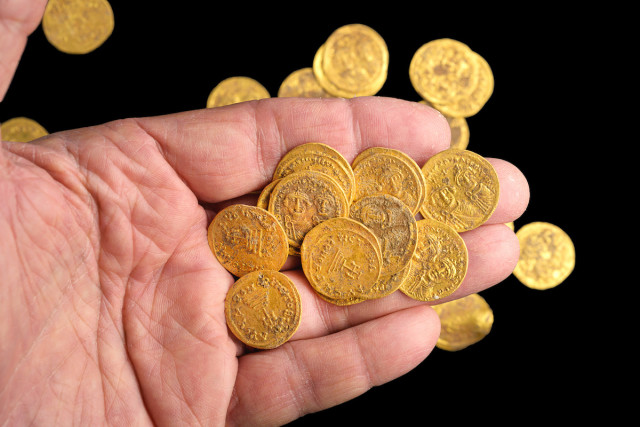Treasure trove of 1600-year-old gold coins discovered in wall
Categories: Nálezy nejenom s detektorem na blízkém východě
A buried hoard of dozens of gold coins has been discovered at an archaeological excavation site near the ancient city of Banias in northern Israel. They date from the Muslim conquest of the region in the 7th century and represent a unique insight into the transitional period after the end of the Roman Empire.
The treasure was discovered three weeks ago at an archaeological site in the Hermon River Nature Reserve. A total of 44 gold coins, weighing 179 grams, lay in the lower hollowed-out section of the stonework. Israeli archaeologists believe the treasure may have been hidden from warriors of the Umayyad Caliphate 1,400 years ago. The original owner probably didn't survive the clash, so the coins hung unnoticed in the wall for a millennium and a half. The region was then part of the Byzantine Empire, the Greek-speaking eastern half of the Roman Empire, which continued to prosper long after the fall of Rome.
The coins depict the faces and names of two Byzantine emperors - the short-reigning and very unpopulardictator Phocas (602-610) and his more successful successor Heraclius (610-641). "The find reflects a particular moment in time when we can imagine the owner hiding his wealth from the threat of war and hopingthat one day he will return to reclaim his property," said Yoav Lerer, head of the excavation department at the Israel Antiquities Authority (IAA). "In retrospect, we know that he was not so lucky..."
"What's particularly interesting about the coins is that at the beginning of Heraclius' reign, they only bear his likeness, but soon he was joined by portraits of members of his family," said IAA numismatist Gabriela Bichovsky. "On the coins you can actually see the process of his sons' growth from childhood until they appear at the same height as their father, who is depicted with a long beard." IAA director Eli Escosido pointed to the significance of the treasure in its historical context, "It dates back to an important transitional period in the history of the city of Banias and the entire Levant region."
The ancient city of Banias was built by the Canaanites. It flourished especially during the early Roman period under Herod the Great. In Christian tradition, it was here that the Apostle Peter was to acknowledge Jesus as the Messiah. The site has long served as an important crossroads between three continents. It has been the centre of several religions, which is why the area is rich in archaeological finds.
Video
Roman Nemec
Sources: i24news.tv, allisrael.com, haaretz.com

44 gold coins weighing a total of 170 grams were hiding 1,400 in the wall

Coins with Emperor Fok

Gold treasure from the wall

Hermon Stream Nature Reserve
The article is included in categories: